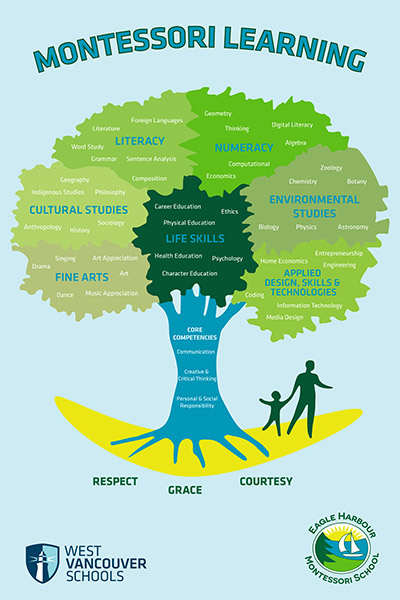
The Montessori Elementary Curriculum
Developing Independent Thinkers
The curriculum at Eagle Harbour Montessori School completely covers the BC Provincial Curriculum and prescribed learning outcomes.
The Montessori elementary curriculum builds on the preschool curriculum and inspires students to become independent thinkers. A Montessori elementary classroom may look quite different than a Montessori preschool environment as students reach the second plane of development and become more social. Eagle Harbour Montessori classrooms are interactive communities where students are often engaged with their peers.
For children ages 6-12, the elementary curriculum encompasses language, math, geometry, physical geography, cultural geography, history, botany, zoology, matter and astronomy. The elementary work frequently involves research, discussion, and large-scale projects. Eagle Harbour teachers introduce an area of study with a presentation of key information or material and then guide the students while they develop individual or small group projects to explore varied facets of the subject.
It is a six year program divided into two, three-year cycles. Multi-age groupings (6-9 and 9-12) promote learning from peers. As in preschool, students work though the Montessori materials, though these are now more complex and age-appropriate.
Integrated studies provide students with unique and age-appropriate materials that help them to become accountable for their use of time, for accuracy in their work and to evaluate their strengths and areas of growth. Our students have individualized work plans to allow them to use time effectively and to make appropriate choices.
Connecting to the Big Picture
The five Great Stories are the foundation of the elementary Montessori curriculum. These stories are used as an introduction to all topics, providing a “big picture” to demonstrate how the sciences, art, history, language, geography are interrelated. From that point, students are introduced to increasing levels of detail and complexity within these broad areas. While working cooperatively and solidifying basic knowledge of reading, writing and mathematics, students research and explore subjects both inside and outside the classroom walls. Lessons given spark the imagination and direct children toward activities that exercise critical and creative thinking abilities and life skills.
Providing Access to Specialized Materials
Our classrooms and materials are organized, tidy, and inviting to the student. There is a deliberate attempt to minimize the number of distractions for the student, so that the student is able to concentrate on the task at hand. Desks are not used. The students are able to choose for themselves the best place to work, whether that is on the floor alone, or with a friend at a table, or perhaps with a small group outside the classroom. Cooperation with other students, willingness to share, and the opportunity to try working with different individuals or groups is fostered by allowing such choices.
Explicit instruction is given to the student in the proper way of using the materials. Montessori materials are attractive, and pleasing to touch, enticing the student to use them in his/her learning. A control of error is embedded in Montessori materials giving students the opportunity for continual feedback.
Students take on the responsibility for their learning. They become self- directed and self-initiating in their learning and discover that their curiosity can drive their learning. The habits for a life-long learner are laid down early in a Montessori education.
